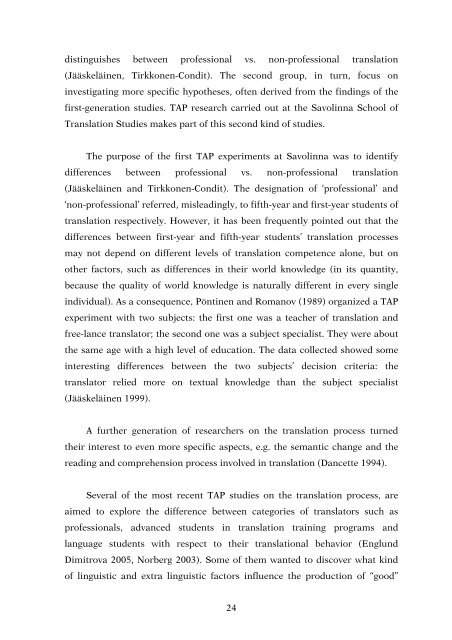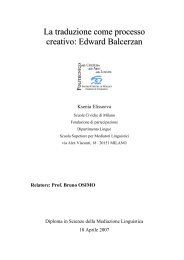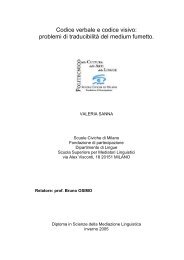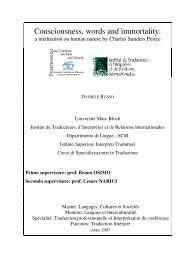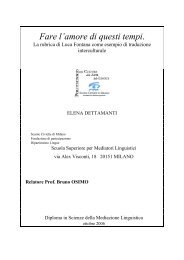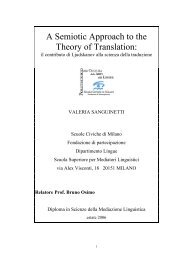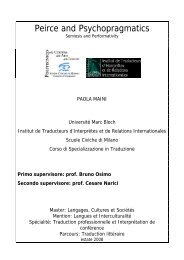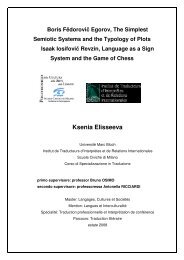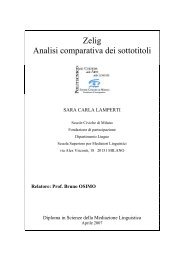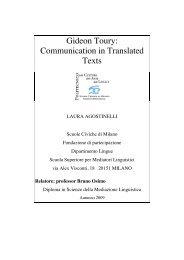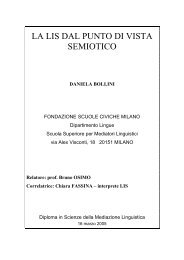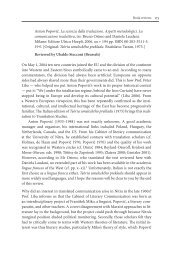Relatore: Professor Bruno OSIMO - Bruno Osimo, traduzioni ...
Relatore: Professor Bruno OSIMO - Bruno Osimo, traduzioni ...
Relatore: Professor Bruno OSIMO - Bruno Osimo, traduzioni ...
You also want an ePaper? Increase the reach of your titles
YUMPU automatically turns print PDFs into web optimized ePapers that Google loves.
distinguishes between professional vs. non-professional translation<br />
(Jääskeläinen, Tirkkonen-Condit). The second group, in turn, focus on<br />
investigating more specific hypotheses, often derived from the findings of the<br />
first-generation studies. TAP research carried out at the Savolinna School of<br />
Translation Studies makes part of this second kind of studies.<br />
The purpose of the first TAP experiments at Savolinna was to identify<br />
differences between professional vs. non-professional translation<br />
(Jääskeläinen and Tirkkonen-Condit). The designation of ‘professional’ and<br />
‘non-professional’ referred, misleadingly, to fifth-year and first-year students of<br />
translation respectively. However, it has been frequently pointed out that the<br />
differences between first-year and fifth-year students’ translation processes<br />
may not depend on different levels of translation competence alone, but on<br />
other factors, such as differences in their world knowledge (in its quantity,<br />
because the quality of world knowledge is naturally different in every single<br />
individual). As a consequence, Pöntinen and Romanov (1989) organized a TAP<br />
experiment with two subjects: the first one was a teacher of translation and<br />
free-lance translator; the second one was a subject specialist. They were about<br />
the same age with a high level of education. The data collected showed some<br />
interesting differences between the two subjects’ decision criteria: the<br />
translator relied more on textual knowledge than the subject specialist<br />
(Jääskeläinen 1999).<br />
A further generation of researchers on the translation process turned<br />
their interest to even more specific aspects, e.g. the semantic change and the<br />
reading and comprehension process involved in translation (Dancette 1994).<br />
Several of the most recent TAP studies on the translation process, are<br />
aimed to explore the difference between categories of translators such as<br />
professionals, advanced students in translation training programs and<br />
language students with respect to their translational behavior (Englund<br />
Dimitrova 2005, Norberg 2003). Some of them wanted to discover what kind<br />
of linguistic and extra linguistic factors influence the production of “good”<br />
24


